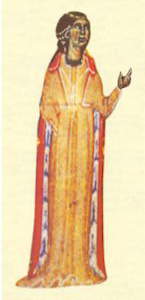
A troubadour was a composer and performer of Old Occitan lyric poetry during the High Middle Ages (1100–1350). Since the word troubadour is etymologically masculine, a female troubadour is usually called a trobairitz.

Aimeric or Aimery de Peguilhan, Peguillan, or Pégulhan was a troubadour born in Peguilhan, the son of a cloth merchant.

Peire Cardenal was a troubadour known for his satirical sirventes and his dislike of the clergy. Ninety-six pieces of his remain, a number rarely matched by other poets of the age.

Na Castelloza was a noblewoman and trobairitz from Auvergne.

The trobairitz were Occitan female troubadours of the 12th and 13th centuries, active from around 1170 to approximately 1260. Trobairitz is both singular and plural.

Gaucelm Faidit was a troubadour, born in Uzerche, in the Limousin, from a family of knights in service of the count of Turenne. He travelled widely in France, Spain, and Hungary. His known patrons include Geoffrey II, Duke of Brittany and Dalfi d'Alvernha; he was also at one time in Poitiers at the court of Richard I of England, for whose death he wrote a famous planh (lament) in 1199. It is possible, though controversial, that Gaucelm took part in the Third Crusade from 1189–1191; it seems clear that in 1202 he set out on the Fourth Crusade, as did his then-patron, Boniface of Montferrat, but after 1202 there is no further historical trace of Gaucelm.

The Song of the Albigensian Crusade is an Old Occitan epic poem narrating events of the Albigensian Crusade from March 1208 to June 1219. Modelled on the Old French chanson de geste, it was composed in two distinct parts: William of Tudela wrote the first towards 1213, and an anonymous continuator finished the account. However, recent studies have proposed the troubadour Gui de Cavalhon as the author of the second part. It is one of three major contemporary narratives of the Albigensian Crusade, the Historia Albigensis of Pierre des Vaux-de-Cernay and the Chronica of William of Puylaurens being the others.

Pons de Capduelh was a troubadour from the Auvergne, probably from Chapteuil. His songs were known for their great gaiety. He was a popular poet and 27 of his songs are preserved, some in as many as 15 manuscripts. Four of his cansos survive with musical notation.

Raimon Jordan was a Toulousain troubadour and the viscount of Saint-Antonin in the Rouergue near the boundary with Quercy. His poetry was in Old Occitan.

Peirol or Peiròl was an Auvergnat troubadour who wrote mostly cansos of courtly love in the late twelfth and early thirteenth centuries. Thirty-four surviving poems written in Occitan have been attributed to him; of these, seventeen have surviving melodies. He is sometimes called Peirol d'Auvergne or Peiròl d'Auvèrnha, and erroneously Pierol.

The (Lo) Monge de Montaudon, born Pèire de Vic, was a nobleman, monk, and troubadour from the Auvergne, born at the castle of Vic-sur-Cère near Aurillac, where he became a Benedictine monk around 1180. According to his vida, he composed "couplets while he was in the monastery and sirventes on subjects that were popular in the region."

Peire d'Alvernhe or d'Alvernha was an Auvergnat troubadour with twenty-one or twenty-four surviving works. He composed in an "esoteric" and "formally complex" style known as the trobar clus. He stands out as the earliest troubadour mentioned by name in Dante's Divine Comedy.

Uc de Saint Circ or Hugues (Hugh) de Saint Circq was a troubadour from Quercy. Uc is perhaps most significant to modern historians as the probable author of several vidas and razos of other troubadours, though only one of Bernart de Ventadorn exists under his name. Forty-four of his songs, including fifteen cansos and only three canso melodies, have survived, along with a didactic manual entitled Ensenhamen d'onor. According to William E. Burgwinkle, as "poet, biographer, literary historian, and mythographer, Uc must be accorded his rightful place as the 'inventor' (trobador) of 'troubadour poetry' and the idealogical trappings with which it came to be associated."

Perdigon or Perdigo was a troubadour from Lespéron in the Gévaudan. Fourteen of his works survive, including three cansos with melodies. He was respected and admired by contemporaries, judging by the widespread inclusion of his work in chansonniers and in citations by other troubadours.

Aimeric de Belenoi was a Gascon troubadour. At least fifteen of his songs survived. Seven others were attributed to him in some medieval manuscripts.

Uc Brunet, Brunec, or Brunenc was a nobleman and troubadour from Rodez in the Rouergue. Six of his works survive.

Albertet de Sestaro, sometimes called Albertet de Terascon, was a Provençal jongleur and troubadour from the Gapençais. Of his total oeuvre, twenty three poems survive. "Albertet" or "Albertetz" is the Occitan diminutive of Albert. Unqualified, it usually refers to Albertet de Sestaro, but there was an Albertet Cailla.

Elias de Barjols was a bourgeois Aquitainian troubadour who established himself in Provence and retired a monk. Eleven of his lyrics survive, but none of his music.

Raimon de (las) Salas or la Sala was a Provençal troubadour probably of the 1220s/1230s. His short vida survives. He left behind four or five poems, but he must have composed more, since he is vida records his composition of cansos, albas, and retroensas. Along with Ferrari da Ferrara, he is the only troubadour known to have tried his hand at the retroensa.
Uc de Lescura or de l'Escura was a minor troubadour. The Lescura of his birth is unknown. There is a Lescurre in Ariège, Aveyron, and Tarn. Based on references in his work, historian Alfred Adler placed him at the court of Alfonso VIII of Castile and in Catalonia.


















